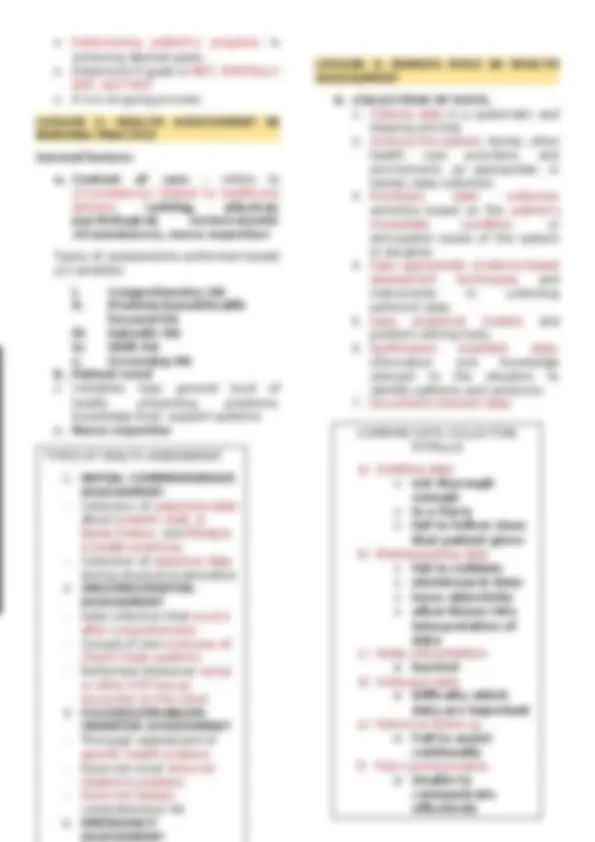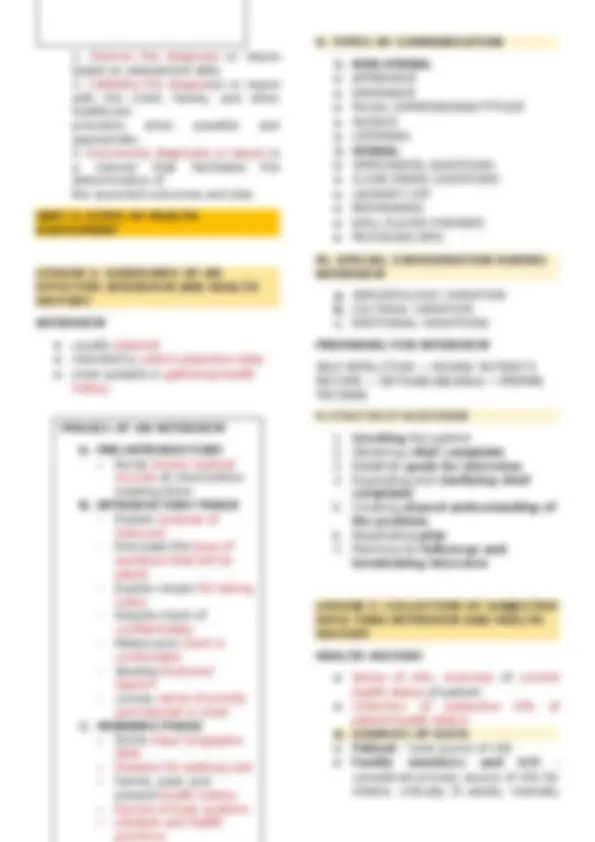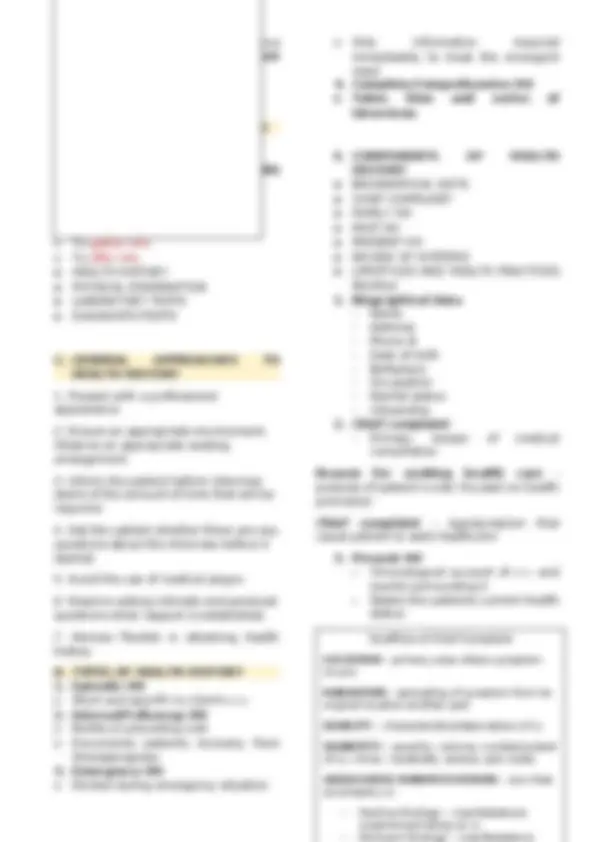





Study with the several resources on Docsity

Earn points by helping other students or get them with a premium plan


Prepare for your exams
Study with the several resources on Docsity

Earn points to download
Earn points by helping other students or get them with a premium plan
Community
Ask the community for help and clear up your study doubts
Discover the best universities in your country according to Docsity users
Free resources
Download our free guides on studying techniques, anxiety management strategies, and thesis advice from Docsity tutors
This contains summarized notes on the overview of the nursing process
Typology: Lecture notes
1 / 6

This page cannot be seen from the preview
Don't miss anything!




o a systematic method of collecting and analyzing data for the purpose of planning patient-centered care. The nurse: o collects data from patient o compare data to ideal state of health o take into account the patient’s age, gender, culture, ethnicity, & physical, psychologic and socioeconomic status Nursing Process is one approach to develop plan of care. Lesson 1: Overview of the Nursing Process PROCESS – series of steps or acts that lead to accomplishment of goal/purpose NURSING PROCESS a. framework for providing professional, quality nursing care. b. Directs nursing activities for health promotion, health protection, disease prevention c. Nurse’s systematic method/approach in identifying, diagnosing & treating human responses to health & illness. d. Purpose: to provide individualized, holistic, effective, & efficient care for clients CHARACTERISTICS OF THE NURSING PROCESS
1. CYCLIC & DYNAMIC e. It is done in a sequential & repeated manner until client’s need are met f. It could be changed or altered depending on the client’s pressing needs 2. CLIENT-CENTERED g. Developed in response to client’s needs h. Aimed primarily to meet needs 3. FOCUSED ON PROBLEM-SOLVING i. nursing problem is formulated to solve current problems of the client that are within the scope of practice and capabilities/knowledge and/or skills of the professional nurse 4. INTERPERSONAL & COLLABORATIVE j. Interpersonal: it involves communication bet. nurse & client k. Collaborative: could be used to refer the client’s condition to other members of the health team 5. UNIVERSALLY APPLICABLE l. Applicable to all patients regardless of nationality/race, culture, condition, etc. 6. INVOLVES CRITICAL THINKING m. Involves analysis of various data & formulation of plans/solutions to meet client’s need. PHASES OF THE NURSING PROCESS A – assessment D – diagnosis P – planning I – implementation E – evaluation 1. ASSESSMENT n. systematic collection of data to determine the patient’s health status and identify any actual or potential health problems Activities during the assessment phase: o conduct health history o perform physical assessment o Interview the patient’s family and s/o o Study the patient’s health record
o Organize & summarize the collected data Primary source of data – THE CLIENT Secondary source of data : o Family members; medical records o Other healthcare providers Types of data: SUBJECTIVE & OBJECTIVE
2. DIAGNOSIS o Process of synthesizing and analyzing data from assessment, and DERIVING meaning from this Activities during diagnosis: o stating problems o identify etiologic/contributory factors o finding relationship among cues o **making inferences
o “SYMPTOMS” o data from client’s pov, includes FEELINGS, PERCEPTIONS, CONCERNS o Something that is felt by the patient e.g. pain o Collected via interview
2. OBJECTIVE DATA o “SIGNS” o are observable & measurable data e.g. temperature, pulse rate, respiratory rate, blood pressure c. Wellness
o APPERANCE o DEMEANOR o FACIAL EXPRESSIONSATTITUDE o SILENCE o LISTENING
2. VERBAL o OPEN-ENDED QUESTIONS o CLOSE ENDED QUESTIONS o LAUNDRY LIST o REPHRASING o WELL PLACED PHRASES o PROVIDING INFO III. SPECIAL CONSIDERATION DURING INTERVIEW a. GERONTOLOGIC VARIATION b. CULTURAL VARIATION c. EMOTIONAL VARIATIONS PREPARING FOR INTERVIEW SELF REFELCTION → REVIEW PATIENT’S RECORD → SET PLANS AND GOALS → PREPARE THE VENUE **IV. STRUCTURE OF AN INTERVIEW
- Nurse review medical records of client before meeting them B. INTRODUCTORY PHASE
handicapped patients, unconscious patients; confirm info that patient provides o Total strangers o Old medical records o Authorities B. METHODS OF DATA GATHERING o INTERVIEW o Conversation with a purpose o Organized conversation with source of data Purposes: o To establish trust and support o To gather info o To offer info o HEALTH HISTORY o PHYSICAL EXAMINATION o LABORATORY TESTS o DIAGNOSTICTESTS C. GENERAL APPROACHES TO HEALTH HISTORY